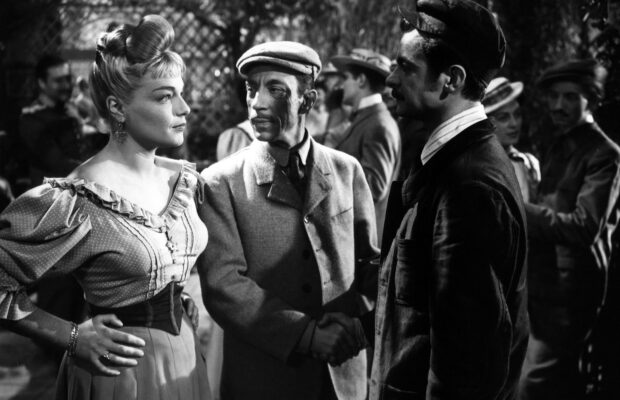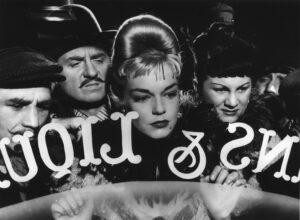Casque d’Or (1952)

Toronto Film Society presented Casque d’Or (1952) on Sunday, November 26, 2023 as part of the Season 76 Fall Series, Programme 1.
Production Companies: Robert et Raymond Hakim, Speva Films, Paris-Film Production. Producers: Raymond Hakim, Robert Hakim, André Paulvé. Director: Jacques Becker. Screenplay: Jacques Becker and Jacques Companeéz. Photography: Robert Lefebvre. Film Editor: Marguerite Renoir. Music: Georges Van Parys.
Cast: Simone Signoret (Marie), Serge Reggiani (Georges Manda), Claude Dauphin (Félix Leca).

Toronto Film Society originally presented Casque d’Or [Golden Helmet] (1952) on Monday, October 17, 1955 as part of the Season 8 Main Series, Programme 1.
Set in the underworld or “demi-monde” of France during the Belle Epoque era of the early 1900s, Casque d’Or is the only one of director Jacques Becker’s 13 narrative features to have received significant U.S. theatrical play while he was alive, and for decades after.
Becker loosely based the film on the scandalous news stories of a supposed love triangle involving real life French prostitute Amélie Hélie and two Apache gang pimps, Joseph Pleigneur (aka Manda) and Dominique Leca. The RKO film The Gigolette was also inspired by Hélie, though the studio didn’t give any credit to the original source. The real Amélie gained notoriety playing herself in the stage musical Casque d’Or et les Apaches. The play was ultimately banned after reigniting the feud between Leca and Manda’s rival gangs. Apache gangs were part of the criminal underworld of the Parisian Belle Époque, named for European’s attribution of savagery to the Native American tribe of the same name. Becker brings this violence to life in the film with Marie, played at the peak of her beauty by Simone Signoret, tempting men into dark alleys who are then beaten and robbed by her Apache gang member accomplices.
Casque d’Or translated literally means “golden helmet” and is Marie’s nickname, a reference to the shimmering blond colour and elevated style of her hair. Though ultimately an ill-fated love story, Marie is the centre of the film, playing a ‘hooker with a heart of gold’ who brushes off the advances of countless men only to fall madly in love with a relative nobody, Manda, played to perfection by Serge Regianni.
An ex-con who’s trying to go straight working as a carpenter, Manda is drawn back into crime because of his attraction to gangster moll Marie. Both Roland (William Sabatier), a member of Leca’s syndicate and Leca (Claude Dauphin) himself don’t like the romance budding between Marie and Manda, which ultimately leads to a tragic ending. Unique among noir films, Becker elicits audience sympathy by humanizing the lead characters only to show the acts of deceit and brutal violence they’ll commit in the name of love.
Rivaling the actors for attention is turn-of-the-century Parisian setting. Becker contrasts the low-lifes with the upper crust of French society, clearly parodying the rich and sympathizing with those on the fringes. It’s also noteworthy that the government and police are portrayed as corrupt and easily outwitted by the criminals, who demonstrate surprising loyalty to their leaders. With rich black and white cinematography, Becker used real locations rather than studio sets, harkening the French New Wave films to come.
In fact, the director was lauded by many New Wave filmmakers and became a major influence to Jacques Truffaut, who said of the film’s masterfully assembled final scene, “If you’re at all interested in how stories are constructed, you cannot fail to admire the ingenuity of the plot, particularly the strong, oblique, unexpected way it gets abruptly to Manda’s execution in a scene that is as beautiful as it is mysterious, as the Casque d’Or [Marie] arrives in the middle of the night at a disreputable hotel. When I or any of my fellow scenarists are in trouble, we often say to each other, ‘How about a Casque d’Or solution?'”
Becker cut his teeth as an assistant to filmmaking genius Jean Renoir, during his most productive period (1932 – 39) and the Belle Époque settings of the film are impressionistic, evocative of his original mentor. With his production perfectionism, and ability to accentuate the story with symbols, suggestions, and foreshadowing of what is to come, it could be argued Becker not only mimicked, but ultimately surpassed his mentor.
In both England and the U.S., distributors tried to come up with a more Anglo-friendly title with various engagements under such titles as The Girl with the Golden Hair, Golden Helmet, Golden Marie, and Casque d’Or, the Story of a Blonde. However, Casque d’Or remained the movie’s name outside of France as well as in, and it’s hard to imagine it being known as anything else. Surprisingly, the film received a lukewarm reception at first upon release in France, however, it’s come to be considered a classic.
Casque d’Or gave Italian actor Regianni, who’d formerly been known for playing seedy, unlikeable villains, the chance to play a more complex and interesting character. He was cast by Becker after acting opposite Signoret in a vignette, La Ronde (1950). The film made Signoret a star, securing her a BAFTA award and leading to her Oscar winning performance in Room at the Top in 1959.
A ravishing melodrama, Casque d’Or is the work of a director at the height of his cinematic powers. Unhindered by the Production Code, Becker allowed the film to be sensual and raw, taking a simple story and bringing to life characters with great depth and complexity. Having died an untimely death from lung cancer in 1960, we can only imagine what masterpieces he might have created.
Notes by Kathleen McLarty










Leave a Reply